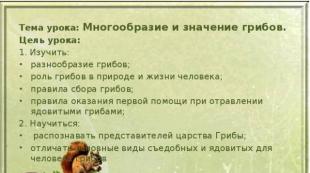How to sharpen a razor at home: instructions for different methods. Sharpening knives: recommendations from experts Sharpen a knife with a knife sharpener
It is simply impossible to describe all the nuances of how to sharpen knives correctly in one article, but this is not always necessary. Especially if an ordinary kitchen knife needs sharpening or you are just a beginner who needs to start somewhere.
- In fact, at home, sharpening a kitchen knife to sharpness can be done quickly and easily. But the difficulty lies in the fact that this must be done in such a way that the sharpness of the blade is preserved for a long time, and at the same time too much steel has not been removed from the blade.
In this material, we will try to simply and clearly talk about how to properly sharpen a knife with a bar. After all, this method is not only basic and accessible to everyone, but also the most effective. Except step by step instructions on sharpening and finishing, here you will find a selection of training videos and an overview alternative methods– starting from sharpening systems and ending with the bottom of a ceramic plate.
A little about the choice of stones
Grinding bars are of the following types:
- Ceramic;
- Diamond;
- natural;
- Japanese water stones.
If you wish, once you gain experience, you can buy some solid and expensive diamond stones or Japanese water ones. However, it is better to start with ordinary ceramic bars (such as "Boats"), which are sold in every hardware store. They are durable, durable and affordable. Of the shortcomings, only their uneven abrasion can be called.
Here are some tips to help you find the right partner:
- What size should the bar be? Ideally, it is 1.5-2 times longer, or at least not shorter than the knife blade. The width and shape of the bar is not critical.
- When buying a bar, make sure it is flat and not chipped.
- To get started, you can buy one general-purpose medium-hard whetstone. But if you want, buy one bar with two sides of different grain sizes or two stones with a large and a half grain size. In the future, a couple more stones may replenish your collection.
- It is best to try to get a couple of Soviet-made whetstones, say, at flea markets or from your grandfather. Bars marked "Made in the USSR" have one-size grains and high-quality binding material.
To bring the knife to razor sharpness, in addition to grindstones, you can also buy GOI abrasive paste, which we will also talk about working with.
7-step guide to sharpening and finishing a kitchen knife
So, in sharpening a knife, one goal is to abrade enough metal from the blade so that the cutting edge becomes sharp again. You need to start work with a coarse-grained abrasive and finish with a fine-grained one.
It is important to remember the following principles for sharpening knives:
- The most important thing is to choose the optimal sharpening angle and hold it on the entire cutting edge while sliding along the bar.
- Movements should be smooth, without pressure.
- All bars should be moistened with water, and preferably with soapy water: before sharpening (so that the blade slides better and metal dust does not clog pores), in the process (to remove the emerging suspension) and at the end to clean the bar.
And one more important advice- the first time it is better to practice on a knife that you do not mind spoiling. Especially if your main knife is too solid and expensive. Well, let's get down to practice.
Step 1. Rinse the stone with water, and then run it over it, say, with a sponge with a drop of dishwashing liquid.

Step 2. Next, sit down at the table and set the stone on wooden board, for example, cutting. You can put under a stone and a towel. It is more convenient for someone to put the bar perpendicular to themselves, and for someone at an angle of about 45 degrees. Over time, you will understand how it is more convenient for you to work.
Step 3. Now you need to decide on the angle of sharpening and fix the position of the knife. What should be the angle? General principle- the smaller it is, the sharper the blade is, and the larger it is, the longer the blade retains its sharpness.
- Ordinary kitchen knives are sharpened at an angle of 40-45 degrees. If you are sharpening a fillet knife (designed for cutting thin pieces of fish, poultry and meat), then it should be sharpened sharper - at an angle of 30-40 degrees. The selected value must be divided by 2, and then we will get the angle that should be between the blade and the surface of the bar. That is, to sharpen the blade at 45 degrees, you need to sharpen each side of it at 22.5 degrees to the grinding surface.
A simple technique shown in the photo below will help you fix the knife at an angle of 22.5 degrees.

- Remember, you should try to stick to the chosen angle during the whole work.
Step 4. We put the knife across the bar so that the upper edge of the handle is above the lower edge of the stone. Holding the handle with one hand and the blade with the other, we begin to slide along the bar away from us along the trajectory shown in the picture below.

Watch this short and descriptive video:
- The bottom line is that the cutting edge sliding on the stone should always be perpendicular to the direction of movement.
- At the bend of the blade, the handle of the knife needs to be slightly raised to maintain the selected angle.
- Remember also that you can not put pressure on the blade, but you should not give slack either.
Thus, it is necessary to pass the blade along the stone about 40-50 times, namely, until a “burr” (burr, microsaws) appears along the entire length of the RK (cutting edge). Its appearance will tell you that the excess metal has worn out and there is no point in grinding further. Then you need to turn the blade over and repeat the same steps. Visually in the video:
- A burr is a small roughness that is difficult to see, but can be felt by gently running your finger along the edge of the blade (but not along the edge, so as not to cut yourself).

During operation, a suspension will appear on the blade - metal dust, which must be periodically washed off with water.
Step 5. So, the burrs have appeared, now we proceed to fine-tuning. To do this, we repeat the same manipulations on a stone with half the grain size. An alternative finishing method is with the help of musat.
- Musat is a steel rod of oval or round section with longitudinal notches. It is suitable only for editing and maintaining sharpness, but not for sharpening a knife. Musat is recommended to edit the knife every time before and after work.
How to edit a kitchen knife with a musat can be seen in the following video master class from the respected cutler Gennady Prokopenkov, who, by the way, specializes in the manufacture of kitchen knives.
Step 6. If desired, you can bring your knife to razor sharpness. To do this, take any skin or leather belt, treat it with GOI, Dialux or any other abrasive paste, and then do all the same steps, but only in the direction from the cutting edge.
Step 7. And finally, we check the quality of sharpening. This is done very simply. It is enough to cut a tomato or cut paper. If you wanted to achieve razor sharpness, then you need to try to shave off the hair on your arm. Most sharp knives they can even cut their hair, as shown in the photo below, however, in the kitchen for the most ordinary knife, such sharpness is not required.

Alternative sharpening methods
If your kitchen knife is a simple and inexpensive “hard worker” and / or you just don’t want to delve into the “knife culture”, then we recommend using an electric sharpener, roller knife sharpener or sharpening system for sharpening at home. What are their pros and cons?
- An electric sharpener sharpens knives perfectly and quickly, but even the highest quality models remove too much material from the blades, thereby reducing its life. Another disadvantage of an electric sharpener is that a good device costs more than $200.
- The roller cutter is inexpensive and easy to use. With it, you can quickly sharpen a kitchen knife, but, unfortunately, the sharpness of the blade will not last long and the knife will deteriorate over time. The tool from Fiskaris (pictured) is the most trusted among roller cutlers. Do not confuse a roller cutter with a V-shaped cutter. The latter is an option for the most careless.

- Grinding systems are good because they allow you to more accurately set and maintain the angle. Such sharpeners are different - with blade fixation (manufacturers DMT and Lanski) and with fixation of the stones themselves at a certain angle (Spyderco Triangle Sharpmaker). Separately, you can highlight the sharpening system in which you can choose the desired angle and control the position of the knife - this is the Edge Pro Apex Knife Sharpening System. Each system has its pros and cons. So, for example, on sharpeners with blade fixation, it is inconvenient to sharpen wide chef's knives, and on Spyderco's triangle, knives are more likely to be corrected than sharpened, and the angle can only be selected 30 or 40 degrees. However, for kitchen knives, just these angles are needed, and using the triangle is very simple. Detailed overview and instruction manual sharpener from Spyderco can be seen in the following video.
What are the disadvantages of Apex Edge Pro? Perhaps this is only a high price - $ 245. However, for sharpening kitchen knives, you can buy a Chinese copy of this sharpener (for example, on Aliexpress).
There is another tricky way to sharpen a knife at home - using a rough risk at the bottom of a ceramic mug or plate. The principle of operation is still the same - maintaining the angle, smooth movements, maintaining the RK (cutting edge) perpendicular to the direction.
Scissors are the second most used cutting tool in the kitchen after the knife. Without them, it is quite difficult to cut fish, some parts of bird carcasses, etc. But, unlike the indicated "king of the kitchen", the zone of their use goes far beyond the boundaries of this territory. After all, there are also scissors for gardening, tailoring, manicure, hairdressing, etc. Depending on their purpose, they have different shape and size. Frequent use will dull the blades. Therefore, you have to think: is it possible and how to sharpen scissors at home? The tips in this article will help you solve this problem. Surely some of them will come in handy due to their simplicity and availability of use, and they will be used by housewives if necessary.
Method one: how to carry out preliminary sharpening "in haste"
It is possible that there are neither special materials nor appropriate sharpening devices at hand. In addition, it is necessary to solve the problem quickly and without delay. After all, there are such situations, for example, when you urgently need to finish the dress, and the scissors began to “chew” the fabric. In this case, take an ordinary needle and, as it were, cut it, guiding it with blades with some effort. You can use a thin glass object (bottle neck) or some iron rod for these purposes. Of course, this method, how to sharpen scissors, does not provide a 100% quality result. But for some time, you can still feel in practice the tangible sharpness of the blades.

Method two: how to sharpen scissors with sandpaper
The technology of the work will be similar to the tips described above. To do this, take a small piece of sandpaper and cut it with scissors in different directions. You can also rub the blades with the specified material, slightly pressing from above. In this case, it is necessary to use coarse-grained material, which is easier to process. When working, it is necessary to take into account that the zone for sharpening is the outer edges of the scissors. You can’t rub the inner surface, otherwise you can not “cure” the instrument, but ruin it. These two options for sharpening scissors are quite simple and affordable. But in order to get a better result, you can use other methods.

Method three: use a file
There are special bars with which you can sharpen not only but also scissors. These also include various blades. For processing with blades, they are carried out several times on the specified object, which lies on a flat surface. With one hand you need to press the bar to the table, and with the other - move the scissors (leaning outside points) in the direction from the handles to the ends. They act a little differently when using a file. It will take some time to sharpen scissors well. In one hand (working) he holds a file by the handle, in the other - open scissors. You can use the tip to rest against any non-slip surface for support. After a few strokes, carefully test the sharpness of the blade surface with your finger.
Method four: how to sharpen scissors using special tools and devices
There are several types of processing devices. First of all, these are, of course, special machines. By way of the lung pressing the blade against a spinning disk and sharpening occurs. Of course, this requires a certain skill and skill. There is also a risk of injury to fingers, so under no circumstances should children be allowed to work on these devices. A simpler and very convenient device, especially for direct use by women, is a sharpener for knives and scissors, sold in supermarkets and hardware stores. Just one movement - and the blades will be sharp without any additional processing. Therefore, it will be very useful for the hostess to have such an item at hand.

Sharpening in several stages
So, having studied all the described options, how to sharpen scissors correctly? If there are no special factory devices in household use, to obtain the most best result work is recommended to be carried out in several stages. To do this, before machining, remove accumulated dirt from the blades with a cotton swab or cloth soaked in solvent. Depending on the purpose of the scissors, this can be earth, food residues, paint, fine fabric dust, etc. Removing the extraneous layer will provide a better result. Then use a file or coarse stone first. After that, to fix the result, use coarse sandpaper, and then fine. And finally, slightly tighten the bolt that tightens the blades. After all, perhaps it was main reason the fact that the scissors do not want to "obey" the master.
All! The tool is ready to go!
A manicure set is an essential companion of every self-respecting woman. He can insure in the most unforeseen situations. In this article, we will look at options for how you can quickly and without much difficulty make nail scissors no less sharp than when you bought it.
When your favorite nail scissors lose their former qualities and become dull, it becomes inconvenient to use them. They no longer cut the nail as perfectly as before, and can even cause microtrauma, as if by chewing on the nail. In this case, you can either throw away the old scissors and buy new ones, or try to correct the situation yourself and sharpen them with the help of improvised means.
What can be done
- Sandpaper works well for this case. It is better to choose one that has a large grain size. Having folded the sheet in half, you can start cutting it, while it is desirable that the blades touch the abrasive for the entire length. With each move, the scissors will become sharper. After finishing the sharpening, you need to wipe this manicure tool with a damp cloth to remove the microparticles remaining on it.
- Ordinary aluminum foil, which is sold everywhere, can also be used as an abrasive material. Having folded it in several layers, you can start cutting into strips. If a strong sharpening of the blades is required, then you need to make as many cuts as possible. After finishing work, you need to wipe the blades.
- A whetstone is perfect for this job. Its coarse-grained part is better suited to start turning when the blades are still very dull. After that, it is better to continue working with a fine-grained surface in order to finish grinding the scissors. Before grinding, you need to disassemble the manicure tool to make it more convenient to work. To do this, just unscrew the central screw and divide it into two halves. After that, you need to put one of the blades with the inner flat side (which is usually in contact with the other half of the scissors) on the touchstone. Next, you need to choose the right angle at which you want to sharpen the blade. A dozen repetitive movements will be enough to complete the job. To understand that the tool is sharp enough, you can mark the sharp parts of the blades with a felt-tip pen before sharpening. If after the procedure the marks are erased, then the scissors are sufficiently sharpened. The check can also be carried out on a piece of polyethylene, if they do not crumple it and cut it easily, then the cutting edges are sharp enough.
- You can use an old unnecessary glass jar for sharpening. To do this, holding the container with one hand, open and close the blades of the scissors with the other, pressing them tightly against the walls of the jar. Glass will make the blades sharper. After finishing the sharpening, do not forget to wipe them with a damp cloth to remove burrs.
- Use a pin or needle according to the same principle as described above. By moving the metal base of the pin between the interlocking blades, you can add sharpness to them with just a few strokes. In this case, you need to watch the blades so as not to get hurt.
- The presence of a diamond wheel will simplify the work at times. At the same time, the effect of its use remains for a long time. When working, you should take into account the shape of the tool, since manicure scissors often have semicircular blades, which requires attention to their processing. Without the skills to work with objects on the machine, it is better not to start it, as you can ruin the scissors by removing too much metal. For rounded blades, the edge of a whetstone with a radius close to the radius of the blade's curvature is ideal.
Many people do not hesitate to throw away scissors that have just become dull, but otherwise work properly. But they can be sharpened quite simply without resorting to the services of special workshops. Thus, having learned how to independently return the scissors to working condition, you can use them for a long time without buying new ones. At the same time, following the advice outlined in the article, you can return your favorite nail scissors to working condition, which you are used to and do not want to change.
Video: how to sharpen nail scissors at home
Numerous manufacturers of men's accessories and shaving accessories offer disposable and reusable razors with blades made from quality materials. But sooner or later, any blade will begin to lose its properties, especially if you do not provide the machine with decent care, proper operation and storage. In this regard, experts offer many methods for sharpening machine blades, many of which can be used at home.
Many men know how to sharpen a razor at home, as several old methods have been practiced for many years. To date, many new ideas have been invented that also quickly and smoothly sharpen blades, extending their life. It is only important to follow all the subtleties and instructions, otherwise the sharp cutting surface may be damaged.
Many men believe that sharpening blades for a machine tool is an unlikely or completely useless task. Especially considering the fact that there is a huge assortment of new blades and cartridges on sale in stores. In fact, high quality razors are worth big money, as well as blades for such models. Therefore, experts recommend saving money and sharpening blades, unless, of course, you use a cheap disposable razor.
Have you ever sharpened a razor?
YesNot
Only a few types of razors can be sharpened in this way:
- disposable machine;
- reusable razors with cassettes;
- T-shaped machines.
If, in addition to proper use and care, sharpening of blades is carried out, a man will be able to provide himself with a high-quality wet shave and save money on buying a machine or blades. Otherwise, the blades will not only cut the hairs badly and pull them out, but also scrape off the top layer of the skin. An important condition for sharpening is to follow the instructions for all stages, otherwise you can dull the cutting surface even more.
For reference! If a man does not have the skills and knowledge of how to sharpen razor blades, you can contact a specialist who has a razor blade sharpening machine and other tools for professional sharpening in his arsenal.
Step by step guide
To date, the most relevant request from men in forums and communities is as follows - how to sharpen razor blades Vest. This manufacturer offers quality machines with interchangeable cassettes, which you can easily extend the shelf life yourself, without the help of a specialist. Most often, two devices for such an action are practiced - a pyramid sharpener for razor blades or ordinary denim.

The pyramid can be made independently from a material that is unable to magnetize, such as plexiglass or cardboard. It is fixed with glue or adhesive tape; metal fasteners are prohibited. Further sharpening is carried out as follows:
- mark the pyramid on a hard, straight surface;
- then the pyramid is oriented to the cardinal points;
- razor blades should be placed along the pyramid in the north-south direction;
- the blades should lie in this state under the pyramid for 6-8 hours.
In the same way, you can sharpen blades for cassette razors, such as Gillette and other brands.

Many men have been successfully practicing the technique for many years, noting its ease of use and high efficiency. Using a special device from RazorPit or Zattoch, blades on a cassette or removable blades are sharpened as follows:
- a little shaving gel is applied to the surface of the device;
- further along the abrasive surface, but in the opposite direction, as during shaving, machine movements are performed;
- do 25-30 such movements at a time;
- at the end, the machine and working attachment will need to be rinsed with water.
Only 5-10 minutes of such manipulations will be enough to reanimate the blades of the machine and give the shaving tool a second life. This will not only save money, but also provide a man with a high-quality and effective shave of stubble and mustache without irritation and other consequences.
Handy tools to help

If a device such as a razor sharpener is not suitable for a man, you can use improvised tools, such as denim. This is one of the first methods that was invented by men many years ago. It is enough just to turn the fabric inside out, and then run the loom with the blades inside against the line of direction of the fabric threads 30-40 times, but without pressure.
Another handy way is a leather belt, and the blades are sharpened in the same way as with denim. You need to choose a belt that does not have frayed areas and creases, otherwise the surface of the blades will be broken. You need to move the blades along the belt from its wrong side. This will preserve the integrity of the painted side of the belt while improving the functionality of the machine.
Is it important to use special devices?

In fact, any selected razor sharpener must be approved by specialists, such as a leather belt, pyramid or denim. Other unfamiliar techniques and untested tools at hand can easily damage the integrity of the blades, since we are talking about a metal plate with a thickness of 0.5 mm or less. Despite the fact that there are many razor sharpeners for sale on the Internet, only a few really do it.
Conclusion
Shaving accessories all have their own service life, which depends on the materials of production of the machine itself and the quality of the blades in it. Disposable razors are used no more than 1-3 times, but T-shaped razors and reusable razors will last longer if cutting parts are changed in time. And in order not to spend money on buying new "feathers", you can sharpen them in a timely manner. To do this, you may need a special device, as well as a pyramid of improvised means, a leather strap or denim.









